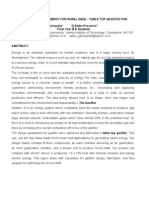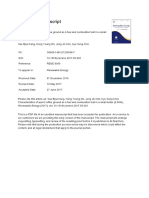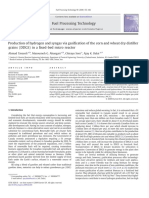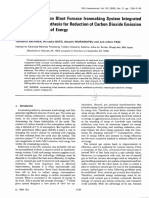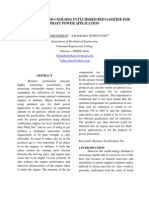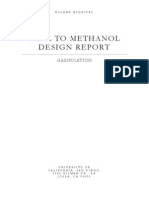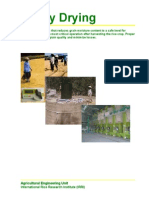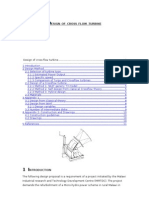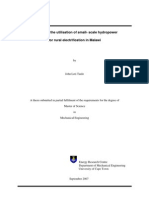Experiment Testing of Top Lit Updraft Coal Stove For Domestic Use in Malawi
Experiment Testing of Top Lit Updraft Coal Stove For Domestic Use in Malawi
Uploaded by
John TauloCopyright:
Available Formats
Experiment Testing of Top Lit Updraft Coal Stove For Domestic Use in Malawi
Experiment Testing of Top Lit Updraft Coal Stove For Domestic Use in Malawi
Uploaded by
John TauloOriginal Title
Copyright
Available Formats
Share this document
Did you find this document useful?
Is this content inappropriate?
Copyright:
Available Formats
Experiment Testing of Top Lit Updraft Coal Stove For Domestic Use in Malawi
Experiment Testing of Top Lit Updraft Coal Stove For Domestic Use in Malawi
Uploaded by
John TauloCopyright:
Available Formats
Experiment testing of Top Lit Updraft Coal Stove for Domestic use in Malawi
by John L Taulo, Deputy Director (Research and Development)
Introduction Combustion of biomass remains the prevalent energy source for cooking and heating of rural households in Malawi, where more than 84.7% of the countrys population resides (Kambewa and Chiwaula, 2010). Approximately 11 million rural people in Malawi still use biomass for cooking, where fuelwood represents approximately 88% of energy used by rural households and 95.4% of total energy use in rural communities (NSO, 2009). Cooking is then often done over open fires, which are highly inefficient transferring only 5-10% of the fuel energy to the cooking pot. The adverse health and socio-economic implications of this form of energy supply are enormous, with women and children at particular risk. The burden of biomass fuel collection and processing for cooking also falls mainly upon women and children (mainly girls), who spend significant time gathering fuel resources every day. Steadily rising firewood consumption for cooking purposes results in deforestation of large areas creating severe ecological problems. In order to protect the environment it is urgently required to utilize alternative methods for cooking purposes. Therefore, providing a clean cooking energy option for these households will yield enormous gains in terms of health and socio-economic welfare of the weakest and the most vulnerable sections of society. At the same time, the cleaner combustion in these devices will greatly reduce the products of incomplete combustion which are greenhouse pollutants, thus helping combat climate change. This study aims at using locally available materials to develop a more efficient, affordable and safe coal-burning stove in which the use of the stove will result in lesser consumption rates of fuel and reduce the indoor air pollution. The stove in the present study follows the principle of producing combustible gases, primarily carbon monoxide, from coal by burning it with limited amount of air. The coal is burnt just enough to convert the fuel into char and allow the oxygen in the char at a higher temperature to produce combustible carbon monoxide (CO), hydrogen (H2), and methane. Other gases, like carbon dioxide (CO2) and water vapour (H2O) which are not combustible, are also produced during gasification. By controlling the air supply with a small fan, the amount of air necessary to gasify coal is achieved. TLUD Coal Stove The TLUD stove (see Fig.1) consists of a cylindrical reactor, an outer cylinder, a gas burner, and a fan. The cylindrical reactor having a diameter of 15 cm and a height of 49 cm is where the fuel is gasified. It is made of 1.6 mm mild steel sheet and is provided with grate at the bottom for the passage of primary air. The grate is made of 12 mm diameter deformed bars with 10 mm
spacing. The outer cylinder serves as stove body and as burner support. The gas burner is where the gas generated from the reactor, mixed with preheated air, and is ignited. The fan is attached to the stove body and is used to supply the air needed for gasification. The primary air enters from the bottom end of the reactor with the use of a 12 cm, 15- watt computer fan. The secondary air, on the other hand, enters the reactor through 16 holes on top of the stove casing having a diameter of 20 mm and is mixed with the gas generated at the small holes located at the upper portion of the burner. Combustible gases are burned in the plate burner consisting of 40 and 45 holes at the inner and outer circles, respectively, with 10-mm diameter.
Results Modified University of California water boiling test (WBT) version 4.12 was used for testing the stove. Burn rate and stove efficiency were determined together with emission factors for carbon dioxide (CO2), carbon monoxide (CO), nitric oxide (NO) and hydrocarbons(HC). Compared to the three stone fire, the coal stove exhibited a higher burn rate (25.57 g/min (1.534 kg h -1)) but lower efficiency. The average computed thermal efficiency of the stove was 18.3%. The CO and CO2 emission was in the range 9 ppm to 5480ppm (10.32-6279 mg/m3) and 1700 ppm to 23, 500 ppm (3060-42,300 mg/m3), respectively. The coal stove recorded mean CO, CO2, HC and NO emission factors of 1.658, 125.2, 0.197 and 0.236 g kg-1, respectively. The emissions and concentrations of carbon monoxide met an emission standard of a CO: CO2 ratio of <0.02. The stove works in the range of 1.578 to 18.93 kW of power rating. The coal stove still requires field testing and user evaluation. This limited series of experiment suggests that the coal burning stove should be carefully designed, constructed and operated. Domestic use of raw coal is not recommended until further investigations are carried out. Conclusion A larger percentage of the population in Malawi relies on biomass fuels and traditional technologies for cooking and heating. And the burning of biomass fuels in the traditional and inefficient cook-stoves has negative impacts on the health of household members. Therefore, in
this study a more efficient coal-burning stove was designed, fabricated and the thermal performance of the stove was compared with that of a traditional stove. The results obtained showed that the combustion of coal in the stove was very slow, resulting in a slow temperature increase in the pot. The coal stove can be operated at power outputs ranging from 1.578 to 18.93 kW at efficiency of approximately 18.3%. The study also showed that the power output of the fire influences the efficiency and emission characteristics of the stove; decreased combustion efficiency could lead to more or less complete combustion and emit more products of incomplete combustion (PICs). Further studies are also needed to explore the relationship between the efficiencies estimated above and the actual rate of household fuel consumption. An integrated assessment of greenhouse gas emissions, thermal efficiency, and health impacts can provide more balanced, fair, and complete evaluation of the stove than only considering one of these parameters. It seems, however, that the design of the coal stove must be improved before it can be promoted as a reliable fuel-saving intervention. The domestic use of coal on a massive scale should not be considered until a more fuel efficient and cleaner burning stove is designed. The work at MIRTDC is underway to perfect this technology by performing extensive experiments on various models.
You might also like
- 2+Sholeha_Effect+of+airflow+rate+and+honeycomb+channels+addition+on+the+efficiency+of+bagasse-fueled+TLUD+gasification+stoveDocument8 pages2+Sholeha_Effect+of+airflow+rate+and+honeycomb+channels+addition+on+the+efficiency+of+bagasse-fueled+TLUD+gasification+stoveAmol GuptaNo ratings yet
- Ilcpa 54 1Document10 pagesIlcpa 54 1reysinogbuhan1No ratings yet
- XXXFuel Particle Size Effect On Performance of Fluidized Bed PDFDocument5 pagesXXXFuel Particle Size Effect On Performance of Fluidized Bed PDFAnkga CamaroNo ratings yet
- 6989-29472-1-PBDocument13 pages6989-29472-1-PBArif KurniawanNo ratings yet
- Abdollahi Ranjbar GholamianDocument20 pagesAbdollahi Ranjbar GholamianLekane nelsonNo ratings yet
- Energies: Study On The Combustion Process of Premixed Methane Flames With CO Dilution at Elevated PressuresDocument17 pagesEnergies: Study On The Combustion Process of Premixed Methane Flames With CO Dilution at Elevated PressuresAnonymous n1qEXWaGNo ratings yet
- Biomass Conversion Technologies: Ralph - Overend@nrel - GovDocument14 pagesBiomass Conversion Technologies: Ralph - Overend@nrel - GovLarissa ZamunerNo ratings yet
- Hong AnalysisDocument38 pagesHong AnalysisleovenuNo ratings yet
- Pi-Wen He 2012 PDFDocument5 pagesPi-Wen He 2012 PDFCris CrisNo ratings yet
- Springer - Bench-Scale Biomass-Coal Cofiring StudiesDocument11 pagesSpringer - Bench-Scale Biomass-Coal Cofiring StudiesZaenalNo ratings yet
- Biomass StoveDocument18 pagesBiomass StoveLakshmanan ThangaveluNo ratings yet
- Fluidized Bed Gasification As A Means of Converting Waste To EnergyDocument28 pagesFluidized Bed Gasification As A Means of Converting Waste To Energyoscop2009No ratings yet
- Coal Drying - Paper 1Document12 pagesCoal Drying - Paper 1Arshad RangwalaNo ratings yet
- 106IJMPERDAUG2018106Document10 pages106IJMPERDAUG2018106TJPRC PublicationsNo ratings yet
- Biomass Gasification Integrated With Pyrolysis in A Circulating Uidised BedDocument5 pagesBiomass Gasification Integrated With Pyrolysis in A Circulating Uidised BedAnil KunworNo ratings yet
- E Ciency Studies of Combination Tube Boilers: Alexandria Engineering JournalDocument10 pagesE Ciency Studies of Combination Tube Boilers: Alexandria Engineering JournalGeslane SchepersNo ratings yet
- GronliDocument5 pagesGronlijtreiber6627No ratings yet
- 1 s2.0 S2214157X21002100 MainDocument11 pages1 s2.0 S2214157X21002100 MainChayapon SaiboutongNo ratings yet
- Renewable Energy: Gerardo Gordillo, Kalyan Annamalai, Nicholas CarlinDocument9 pagesRenewable Energy: Gerardo Gordillo, Kalyan Annamalai, Nicholas CarlinAlan D. Surco HuahuasonccoNo ratings yet
- Renewable Energy For Rural India - Table Top Gasification M.S.Balachandar G.Sethu Prasanna Final Year B.E StudentsDocument5 pagesRenewable Energy For Rural India - Table Top Gasification M.S.Balachandar G.Sethu Prasanna Final Year B.E StudentsSudhir RoyNo ratings yet
- GabissaDocument19 pagesGabissaAshenafiNo ratings yet
- Experimental Study On The Combustion of Gaseous Based Fuel (LPG) in A Tangential Swirl Burner of A Steam BoilerDocument15 pagesExperimental Study On The Combustion of Gaseous Based Fuel (LPG) in A Tangential Swirl Burner of A Steam Boilerkarrar salahNo ratings yet
- Integration of Power Plant and Amine Scrubbing To Reduce CO2 Capture CostsDocument26 pagesIntegration of Power Plant and Amine Scrubbing To Reduce CO2 Capture CostsshubhamNo ratings yet
- Charcoal Haiti1Document18 pagesCharcoal Haiti1996432No ratings yet
- Pers Cct2003Document8 pagesPers Cct2003VIJAYPORNo ratings yet
- Energies: Thermal EDocument11 pagesEnergies: Thermal EAlfonso BlancoNo ratings yet
- Characteristics of Spent Coffee Ground As A Fuel and Combustion Test in A Small BoilerDocument15 pagesCharacteristics of Spent Coffee Ground As A Fuel and Combustion Test in A Small BoilerMJundiNo ratings yet
- Characteristics of Spent Coffee Ground As A Fuel and Combustion Test in A Small Boiler PDFDocument15 pagesCharacteristics of Spent Coffee Ground As A Fuel and Combustion Test in A Small Boiler PDFMJundiNo ratings yet
- Fuel Processing Technology: Ahmad Tavasoli, Masoumeh G. Ahangari, Chirayu Soni, Ajay K. DalaiDocument11 pagesFuel Processing Technology: Ahmad Tavasoli, Masoumeh G. Ahangari, Chirayu Soni, Ajay K. DalaiJaydeep PatelNo ratings yet
- Crown Capital Eco Management Environmental NewsDocument9 pagesCrown Capital Eco Management Environmental Newsmariangriffin012No ratings yet
- System Use: Methanol Carbon andDocument8 pagesSystem Use: Methanol Carbon andakshukNo ratings yet
- Analysis of A Bayonet Tube Heat Exchanger: T. O'Doherty, A.J. Jolly, C.J. BatesDocument18 pagesAnalysis of A Bayonet Tube Heat Exchanger: T. O'Doherty, A.J. Jolly, C.J. BatesMelanie PooleNo ratings yet
- Available & Emerging Tech For Reducing GHG 03Document2 pagesAvailable & Emerging Tech For Reducing GHG 03Amit DwivediNo ratings yet
- The Gas Turbine SolutionDocument1 pageThe Gas Turbine Solutiontanjq87No ratings yet
- 208 1132 1 PB PDFDocument9 pages208 1132 1 PB PDFOnCo TallaNo ratings yet
- Final Narrative 2013NSDCDocument39 pagesFinal Narrative 2013NSDCMisgatesNo ratings yet
- 2 China PDFDocument4 pages2 China PDFSiddharth ModiNo ratings yet
- Fluidized Bed Combustion (FBC) in Coal Based Thermal Power PlantsDocument10 pagesFluidized Bed Combustion (FBC) in Coal Based Thermal Power PlantsShambhu MehtaNo ratings yet
- Burning of WoodDocument9 pagesBurning of WoodwhhojhNo ratings yet
- Gas Cleaning and Cooliing in Fluidized Bed Gasifier For Shaft Power ApplicationDocument6 pagesGas Cleaning and Cooliing in Fluidized Bed Gasifier For Shaft Power ApplicationDeepak KumarNo ratings yet
- Thesis Technical PaperDocument8 pagesThesis Technical PaperJhiGz Llausas de GuzmanNo ratings yet
- CFD Modeling of Waste Heat Recovery On The Rotary Kiln System in The Cement IndustryDocument17 pagesCFD Modeling of Waste Heat Recovery On The Rotary Kiln System in The Cement Industryghada ghoudiNo ratings yet
- Reed Briquets in Domestic HeatingDocument4 pagesReed Briquets in Domestic HeatingDan ErvinNo ratings yet
- Z-Tar 2Document44 pagesZ-Tar 2tamil thendralNo ratings yet
- Combustion and Environmental Performance of Clean Coal End ProductsDocument14 pagesCombustion and Environmental Performance of Clean Coal End ProductsΘΕΜΗΣ ΦΩΤΙΑΔΗΣNo ratings yet
- G G G G H: HydrocarbonDocument11 pagesG G G G H: Hydrocarbonlance barredoNo ratings yet
- Journal Pre-Proof: EnergyDocument31 pagesJournal Pre-Proof: EnergyAndreea MadalinaNo ratings yet
- Study On Combustion Characteristics of Fully PremixedDocument13 pagesStudy On Combustion Characteristics of Fully Premixedpolyakovmv18No ratings yet
- Thermodynamics Equilibrium Analysis Within The Entrained Flow Gasifier EnviromentalDocument8 pagesThermodynamics Equilibrium Analysis Within The Entrained Flow Gasifier Enviromentalproleceo11No ratings yet
- Experiment On Enhancing Heat Transfer - EGT Using Turbulence Promoters and Cross Flow HX With DI/Ag+ Nano ParticlesDocument19 pagesExperiment On Enhancing Heat Transfer - EGT Using Turbulence Promoters and Cross Flow HX With DI/Ag+ Nano ParticlesvinayNo ratings yet
- Energies: Gasification of Biochar From Empty Fruit Bunch in A Fluidized Bed ReactorDocument9 pagesEnergies: Gasification of Biochar From Empty Fruit Bunch in A Fluidized Bed ReactoryemresimsekNo ratings yet
- Saving Fuel Consumption and Reducing Pollution Emissions For Industrial Furnace - Lee - 2011Document6 pagesSaving Fuel Consumption and Reducing Pollution Emissions For Industrial Furnace - Lee - 2011Vaso ManojlovićNo ratings yet
- Gas Stove ebook mergedDocument16 pagesGas Stove ebook mergedkatakamvraoNo ratings yet
- Proceedings of The Combustion Institute 2011 - Glycerol Combustion and EmissionsDocument8 pagesProceedings of The Combustion Institute 2011 - Glycerol Combustion and EmissionsLaurencas RaslaviciusNo ratings yet
- Coal To Methanol p2Document8 pagesCoal To Methanol p2moeeezNo ratings yet
- Energies 13 04764Document24 pagesEnergies 13 04764Prith HarasgamaNo ratings yet
- Er 2646524656Document5 pagesEr 2646524656IJMERNo ratings yet
- Clean Ironmaking and Steelmaking Processes: Efficient Technologies for Greenhouse Emissions AbatementFrom EverandClean Ironmaking and Steelmaking Processes: Efficient Technologies for Greenhouse Emissions AbatementNo ratings yet
- Good Stoves Facilitation: How to Innovate and Change the WorldFrom EverandGood Stoves Facilitation: How to Innovate and Change the WorldNo ratings yet
- Reviewed Energy Supply Paper 2015.04.09Document20 pagesReviewed Energy Supply Paper 2015.04.09John TauloNo ratings yet
- Training Manual Paddy DryingDocument49 pagesTraining Manual Paddy DryingJohn TauloNo ratings yet
- Design Proposal For Mechanical Components - 1Document12 pagesDesign Proposal For Mechanical Components - 1John Taulo100% (2)
- MSC Thesis - Final CopyDocument188 pagesMSC Thesis - Final CopyJohn TauloNo ratings yet
- 2009.10.13 Design and Performance Evaluation of Automatic Egg IncubatorDocument13 pages2009.10.13 Design and Performance Evaluation of Automatic Egg IncubatorJohn Taulo100% (1)



















